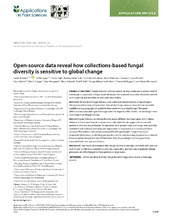| dc.contributor.author | Andrew, Carrie Joy | |
| dc.contributor.author | Büntgen, Ulf | |
| dc.contributor.author | Egli, Simon | |
| dc.contributor.author | Senn-Irlet, Beatrice | |
| dc.contributor.author | Grytnes, John-Arvid | |
| dc.contributor.author | Heilmann-Clausen, Jacob | |
| dc.contributor.author | Boddy, Lynne | |
| dc.contributor.author | Bässler, Claus | |
| dc.contributor.author | Gange, Alan C. | |
| dc.contributor.author | Heegaard, Einar | |
| dc.contributor.author | Høiland, Klaus | |
| dc.contributor.author | Kirk, Paul M. | |
| dc.contributor.author | Krisai-Greilhüber, Irmgard | |
| dc.contributor.author | Kuyper, Thomas W. | |
| dc.contributor.author | Kauserud, Håvard | |
| dc.date.accessioned | 2019-11-07T14:02:05Z | |
| dc.date.available | 2019-11-07T14:02:05Z | |
| dc.date.issued | 2019 | |
| dc.Published | Andrew CJ, Büntgen U, Egli S, Senn-Irlet B, Grytnes J, Heilmann-Clausen J, Boddy L, Bässler C, Gange AC, Heegaard E, Høiland K, Kirk PM, Krisai-Greilhüber, Kuyper TW, Kauserud H. Open-source data reveal how collections-based fungal diversity is sensitive to global change. Applications in Plant Sciences. 2019;7(3):e1227 | eng |
| dc.identifier.issn | 2168-0450 | en_US |
| dc.identifier.uri | http://hdl.handle.net/1956/20961 | |
| dc.description.abstract | Premise of the Study Fungal diversity (richness) trends at large scales are in urgent need of investigation, especially through novel situations that combine long‐term observational with environmental and remotely sensed open‐source data. Methods We modeled fungal richness, with collections‐based records of saprotrophic (decaying) and ectomycorrhizal (plant mutualistic) fungi, using an array of environmental variables across geographical gradients from northern to central Europe. Temporal differences in covariables granted insight into the impacts of the shorter‐ versus longer‐term environment on fungal richness. Results Fungal richness varied significantly across different land‐use types, with highest richness in forests and lowest in urban areas. Latitudinal trends supported a unimodal pattern in diversity across Europe. Temperature, both annual mean and range, was positively correlated with richness, indicating the importance of seasonality in increasing richness amounts. Precipitation seasonality notably affected saprotrophic fungal diversity (a unimodal relationship), as did daily precipitation of the collection day (negatively correlated). Ectomycorrhizal fungal richness differed from that of saprotrophs by being positively associated with tree species richness. Discussion Our results demonstrate that fungal richness is strongly correlated with land use and climate conditions, especially concerning seasonality, and that ongoing global change processes will affect fungal richness patterns at large scales. | en_US |
| dc.language.iso | eng | eng |
| dc.publisher | Wiley | en_US |
| dc.rights | Attribution CC BY | eng |
| dc.rights.uri | http://creativecommons.org/licenses/by/4.0/ | eng |
| dc.subject | collections data | eng |
| dc.subject | diversity | eng |
| dc.subject | fungi | eng |
| dc.subject | macroecology | eng |
| dc.subject | open-source | eng |
| dc.subject | phenology records | eng |
| dc.title | Open-source data reveal how collections-based fungal diversity is sensitive to global change | en_US |
| dc.type | Peer reviewed | |
| dc.type | Journal article | |
| dc.date.updated | 2019-09-04T13:15:11Z | |
| dc.description.version | publishedVersion | en_US |
| dc.rights.holder | Copyright 2019 Andrew et al. | en_US |
| dc.identifier.doi | https://doi.org/10.1002/aps3.1227 | |
| dc.identifier.cristin | 1704889 | |
| dc.source.journal | Applications in Plant Sciences | |

